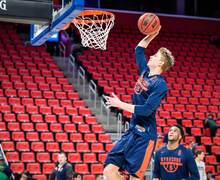The shorter the better: Syracuse keeps practices to 90 minutes, below national average
Alexandra Moreo | Senior Staff Photographer
Marek Dolezaj practices before last year's NCAA Tournament.
Jim Boeheim blew his whistle and then-first-year assistant coach Allen Griffin couldn’t believe it. Syracuse players met with coaches in a huddle, then dispersed through the Carmelo K. Anthony Center. Practice had ended one afternoon at 5:30, 90 minutes after the usual 4 p.m. start time.
Griffin knew Boeheim likes to keep things simple. Just as Boeheim’s timeout and halftime speeches are short, practice instruction is kept to a minimum. But early last season, Boeheim had called practice after an hour and a half. Most top-tier programs practice for two to three hours, according to Griffin and several other college basketball coaches.
“Gotta keep ‘em fresh,” is the SU practice motto, per Griffin, who’s coached at Providence, Hofstra, Dayton and now Syracuse.
While many teams use the NCAA’s 20 practice hours per week to the maximum, the Orange (20-12, 10-8 Atlantic Coast) practice only 90 minutes a day. Sometimes, even less — especially during the NCAA Tournament, which begins for SU on Thursday against Baylor (19-13, 10-8 Big 12). The first few practices of every season run longer, former and current players said, but Boeheim prides intensity over duration. Quality over quantity. Short spurts over long drills. He believes in practicing the fundamentals and what’s most pressing for the next game.
Former and current players say Boeheim and his staff have a knack for distilling complicated scouting reports, hours of film and decades of basketball wisdom into something digestible. They are meticulously detailed, scheduling most drills down to the minute, senior Frank Howard said.
“Some days we only practice an hour and 10 minutes or so,” freshman point guard Jalen Carey said. “When you’re sore, that really helps.”

Susie Teuscher | Digital Design Editor
Boeheim’s practice philosophy aligns with that of legendary coach John Wooden, who won 10 national titles at the University of California, Los Angeles. Wooden kept practices to two hours or less, because he believed in quick transitions between drills and few long talks with his team. Wooden’s written in his books that he usually spent more time planning practices than running them.
At SU, there are few practice drills in which individual work is prioritized. The widely-held belief is that players can work out on their own before or after, but not during. There are few drills centered on conditioning, said director of operations Kip Wellman, who added that he “can’t recall anybody ever running one suicide” — a grueling running drill — since he took on his role six years ago.
“When you’re close to three hours every practice, you lose the guys at some point,” Wellman said. “But also, from a fatigue standpoint, you’ll wear them down. It’s a long season. Some coaches see these guys as 18, 19 years old, and they say, ‘They can run all day.’ But you’re also wearing them down mentally. There comes a point when you can only consume so much and then you don’t hear the rest.”
Former Syracuse forward Wesley Johnson (2009-10), now with the Washington Wizards, said practice at SU rarely exceeded 90 minutes. Sometimes, practice lasted only about 75 or 80 minutes, he said — “way less” than his two seasons at Iowa State where it pushed three hours.
All college programs must take one day off per week, per NCAA rules. For Syracuse, the break depends on the week’s game schedule. Usually, Boeheim plans the day off to give the Orange at least two days to prepare for an opponent. During regular season in which SU plays Tuesday and Saturday, the Orange typically don’t practice on Wednesday, giving them two days to ready for a weekend game.
Syracuse practices start at 4 p.m. during the season. For the NCAA Tournament, they vary depending on site and time of game. They usually start with an active warm-up and stretch, followed by group work — bigs and guards separate — from about 4:10 p.m. to 4:30 p.m. When the 2-3 zone is effective, Wellman said, practice segues into offense work such as “five man” — a common drill in which five players work through plays with no defenders involved. Transition drills, defensive tweaks and free throws also are built into most practices.
When SU travels to Salt Lake City, Utah for the Tournament this week, with all the distractions surrounding them, practices will stay simple. They’ve run things this way for decades.
“We play hard the entire practice, so I don’t think the length matters,” said Tyus Battle. “It’s short, but that lets me go in there an hour before and an hour after to get my own work in, without being tired.”
Published on March 17, 2019 at 11:09 pm
Contact Matthew: mguti100@syr.edu | @MatthewGut21




